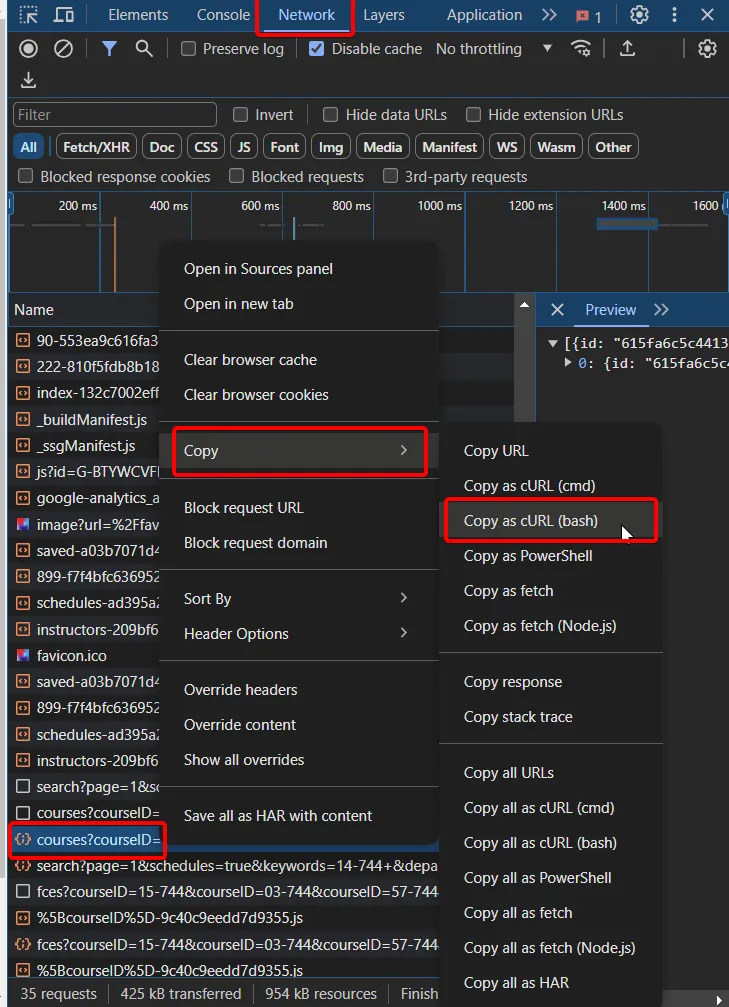Command-line network requests
import { Image } from ‘astro
’; import chrome-curl from ’../../../assets/chrome-curl.png’;Network Requests
Web Interactions
curl (cURL)
We’ve already used it a ton in this class; curl allows you to send general network requests via the command-line. By default, the downloaded content is written to stdout
$ curl -s https://intro-to-cmdline-tools.jtledon.com/parsetext/jledon.txt 2> /dev/null | grep ...The above structure is a very common way to format a pipeline of commands. Request some amount of data from a url and then perform some operations on it - in this case, grep.
Some of the most common flags that you will find useful:
$ curl [--header|-H] # send http headers in the curl request$ curl [--data.*] # send various forms of POST request data$ curl [--output|-o] # rather than writing to stdout, write to a file insteadChrome requests
Chrome offers some really handy dev tools that allow you to record network requests being made by a website, and copy that request as a curl command:

wget
wget tends to be used for strictly downloading content from websites, rather than interacting with the website with something like a POST request. It differs from curl in many ways, one of them being that it downloads to a file by default, rather than printing to stdout
Generally, you are just going to pass in a link to a web-hosted file (like a .tar.gz) and download that:
$ wget https://github.com/BurntSushi/ripgrep/releases/download/14.1.0/ripgrep-14.1.0-x86_64-unknown-linux-musl.tar.gzOne of the ways that I like to use wget is to recursively walk a website and all of its hyperlinks, downloading each page for offline viewing:
$ wget --recursive --no-clobber --page-requisites --html-extension --convert-links --progress=bar --restrict-file-name=windows --no-parent --directory-prefix=...Moving Data
rsync
Some of the syntax can be unintuitive when specifying what files to transfer:
$ rsync ~/src ~/dest # the src folder, as well as its contents will be put into the dest folder$ rsync ~/src/ ~/dest # the _contents_ of the src folder will be place in the dest folder$ rsync ~/src/ ~/dest/ # a / on the end of the destination makes no differenceYou can check out the usage section in rsync’s man page to read more about the syntax.
You almost always going to want to use the -a flag. It is a combination of a variety of useful flags -rlptgoD, with notable ones being --recursive (recurse into directories) and --perms (preserve permissions), as well as adding transfer compression to reduce transfer file size.
$ rsync -a /mnt/d/Documents/CMU/18646/assignments jledon@unix.andrew.cmu.edu:/afs/ece.cmu.edu/usr/jledon/private/18646/It is notably faster than most other copying commands because it has its own delta-transfer algorithm to reduce sending any data that is already in the destination.
It also has great debug flags with -vvv
scp (Secure cp)
scp is the traditional way of transferring files between your computer and a remote host. It is notably slower, but is the standard and will be supported on pretty much any unix based machine; this cannot be said for rsync, and some older machines wont have it installed: one important example being the ECE machines
$ scp -P 22000 -i ~/.ssh/749-user.pem file.txt jledon@unix.andrew.cmu.edu:/afs/ece.cmu.edu/usr/jledon/Specifying the destination port and ssh-key are two of the more commonly used options when using scp.
Other Useful Tools
dig
This utility will return the DNS information of the requested site, which can be particularly useful when resolving network connection issues.
$ dig www.google.comnslookup
This utility will query a nameserver in an attempt to resolve a DNS lookup, returning the IP addresses that are associated with the provided A-Record
$ nslookup www.google.comping
ping is just going to make a network connection to a server and see if it responds. It is mostly going to be used as a sanity check to see if you have any sort of internet connection.
$ ping www.google.comnetcat nc
This general purpose networking utility allows for a ton of network connection options. It’s a common choice for setting up reverse shells, watching network traffic, scanning for open ports on a server, and much more.
I recommend checking out the tldr page on netcat to get a better idea of its capabilities
Homework
This will be similar to the exam. Provide a string of characters that you can press that will make the following changes:
- change the type on line 9 to
int - delete everything after line 20
- change the
requestUrivariable to splitcourseat 3, not at 2.
 file here
file here
All the letters should be in one string, with no spaces. If you need to type an Escape, use <esc> in your canvas submission, if you need to type Enter, use <cr>, which stands for carriage return.
An example might be: I"<esc>4jA,
You can follow this video to learn how to interact with registers and test your command.
Submit this assignment on canvas in the appropriate assignment on canvas. Include both a video of you interacting with the registers, yanking a command string into a register, and running it to show your changes being executed to solve the homework. Please also include your command string as plaintext, with the swapped out